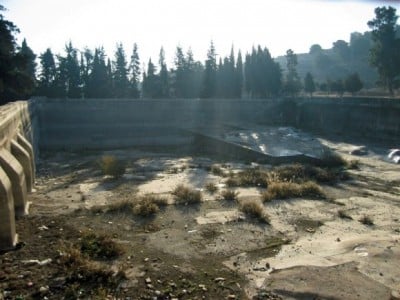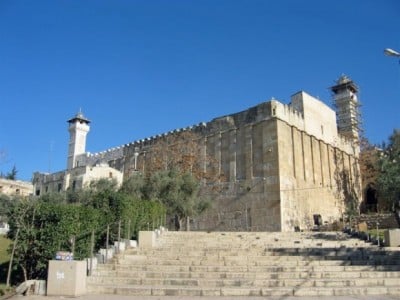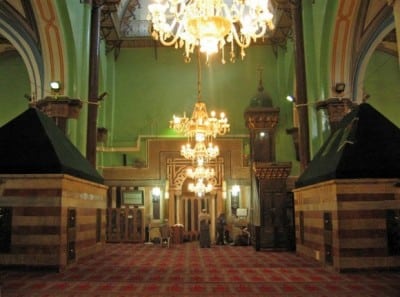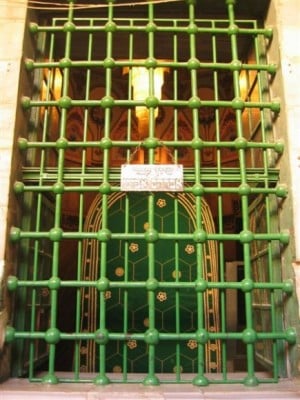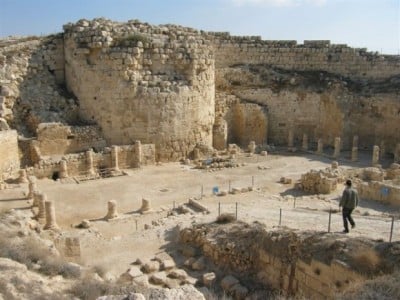Today we had another field trip. This morning we started out by visiting Solomon’s Pools. These are huge reservoirs near Bethlehem that were constructed to be a water supply for Jerusalem. The aqueduct that ran for miles and miles is still visible in places. We saw what our guide told us was the “small” one of the three pools and it was huge. Picture a swimming pool the size of a football field and 50 feet deep.
One of Solomon’s Pools
From there we went on to the famous city of Hebron. It was here that David was crowned king. However, the town is most famous for being the burial place of the patriarchs Abraham, Isaac, and Jacob. You can read in the book of Genesis how Abraham bargained to buy a cave at Hebron to bury his wife Sarah. He was later buried there as well as Isaac and Rebecca, and Jacob and Leah (Rachel is buried on the way to Bethlehem). Joseph is also buried there. King Herod the Great built a large complex on top of the cave sometime shortly before the birth of Jesus. The stones are original and identical to the construction of the wall of the temple still visible in Jerusalem. The stone work is amazing. Some of these stones are just huge. The smallest one weighs 50 tons and yet they’re all stacked up on top of each other and have stayed there unbothered for 2000 years.
Herod the Great’s Tomb of the Patriarchs
Inside, the site is divided into a Muslim half and a Jewish half. We were very fortunate in that we got to visit both sides. Our guide had never been allowed into Jewish side before. On the Jewish side are the graves of Jacob and Leah, Abraham and Sarah, and Joseph. On the Muslim side is a very beautiful Mosque with the graves of Isaac and Rebecca and also has access to Abraham and Sarah. This was my first time in a Mosque. This is the fourth holiest Mosque in the world for the Muslims, so this was a good first Mosque for me to visit. I guess I should clarify that when I referred to the “graves” above. I really mean grave markers or cenotaphs. The actual graves are very deep in the earth below the building in the original cave that Abraham bought. Medieval pilgrims were able to descend a set of stairs down to the cave, but access has been cut off. There is a hole in the Mosque that supposedly leads down to the cave, but there was no light to see. As with most the places in the holy land, you can never be exactly sure that you’re at the precise spot, but that’s really not the point. Even if this isn’t the actual cave, and I just assume that it is in fact the actual cave mentioned in the Bible, you still know that it has to be right around here. Abraham was definitely here in this area. The scientist in me really wants to go down to the cave below and find the actual graves, but it is enough to trust that it is there. The purpose is still served. These were real people! They have to be buried somewhere and it might as well be here. You really come to see that the earth is only so big and you’re as close as you could ever hope to get to touching history.
The Abraham Mosque (Cenotaph of Rebecca on Left, Isaac on Right)
I’ve always loved the stories of the Old Testament and it was an amazing feeling to be able to pray there in what is possibly the world’s most famous hall of fame. I was reminded of the fact that Abraham is buried here in a land that was not his home. He too was a pilgrim who left Ur when God called him and set out on a journey. As I passed by each cenotaph the stories of the Bible flashed before my mind and I was conscious of the fact that these famous people of faith lived real lives in a real place. As much as you think you get what that means when you’re at home, it’s just different here. I’ve never doubted the existence of the patriarchs or their stories, but being here at their final resting place really made them seem real to me. As I prayed today, my thoughts turned to heaven. As exciting as it was to enter the tombs of these giants in faith, I can’t wait to meet them in person in heaven. When you think that Abraham’s body has been lying in the cave for thousands of years, the short span of my own life, however long it may be, reminds me that it won’t be too long and I’ll get my wish. Until then, I remain a pilgrim on earth presently in the Holy Land like the patriarchs once were.
The Cenotaph of Abraham
On our way back from Hebron we stopped at a place known as the Herodian, named after Herod the Great. This is a big mountain that looks like a volcano. In the middle are the ruins of one of King Herod’s palaces. It was a big climb to the top and we came out through a hidden network of secret caves used for hiding and clandestine attacks. It was a very impressive looking structure, but the view from the top was equally impressive. Once again, just walking around in something 2000 years old and touching everything is an experience I’m still getting used to. Until next time.
Runis of King Herod’s Palace

